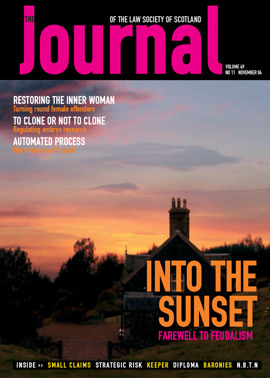Keep the eye on the ball

Recently I was given a collection of reports of annual meetings of the Council of the Incorporated Society of Law Agents in Scotland for the period from 1912 to 1932 (long before the days of the present Law Society of Scotland). I note that legal education and the regulation of the profession were prominent topics throughout. It was perhaps not surprising that they noted with concern that in 1917-1918 only 17 people were enrolled to study law in Scottish universities. Women had not been admitted to the profession by then, and a decision on whether it was appropriate to admit them at all was deferred until it was seen how the size of the profession was affected by the casualties of war.
There could be no more stark reminder that life was very different then. Yet the themes of their discussions about the best ways of acquiring legal knowledge, practice skills and professionalism are little different from those underlying the Society’s paper “Lawyers of the Future,” with its draft Foundation Document and the work of the Diploma in Legal Practice Project Board. The language of those days, although outmoded in places, is succinct and free of jargon and acronym. The banks are berated for encroaching on legal business. University law teaching is criticised as too far removed from practice (in those days meaning too historical). There is a even a neat justification for the inclusion of accounting in the professional education; accounting is simply the expression of legal rules in figures rather than words, and lawyers must understand that form of expression.
Fertile source of argument
The progress of the last decade of review of the route from theory to profession has also been reported in this Journal1 and other legal periodicals,2 but I have not contributed to that published dialogue before now, tending to keep my contributions for the fora designed to allow liaison between the Society and the providers of legal education (in particular the Diploma Co-ordinating Committee and the Joint Standing Committee on Legal Education). Sadly over recent years it has not been possible for the Society’s committee representatives to find time to attend many of these meetings (particularly of the Diploma Co-ordinating Committee), but now the opportunity for greater discussion exists in the form of the Diploma Project Board conference on 4 December, and I look forward to hearing new views about how the Diploma could be improved. These views, if the past is anything to go by, will be wide-ranging, diametrically opposed and will embrace structure, content and methods of delivery. The challenge will be to draw out from these views, realistic and assessable means of ensuring consistency, while respecting and reflecting the eclectic variety of approaches that exist in our profession, all meeting professional “core values”.
The Diploma being the most lengthy, personally costly and exposed part of professional legal education (exposed from the home straight of traineeship), it attracts the most comment from students, their parents and training firms for its perceived shortcomings. The Diploma relies heavily on practitioners willing to display and impart professional values as they teach. An underestimated feature of the Diploma is the very introduction of students to a range of professional personae outside direct employment, exposing a range of attitudes and methods to mould entrants in acquisition of their own distinct style of professionalism. People like me carry the responsibility of bridging the gap between the aspirations for professional legal education in the Diploma and the reality of its delivery by members of that profession.
Constant search for the best
To do so we are assisted by our own legal professional skills and values, but perfection is the holy grail and innovative methods are attempted and refined to make the process more effective. One example is described in Professor Maharg’s piece entitled “Virtual firms: transactional learning on the web” (www.journalonline.co.uk/ submissions),3 and in Aberdeen our work-shadowing scheme and assessment of criminal procedure learning through a report based on attending courts are attempts to engage professional contexts directly with Diploma learning. An almost continuous process of review and development is inevitable. If the work done in Diploma units is to be for the good of the whole profession, then sharing good practice and common materials makes a lot of sense. We all want to deliver the best possible within our powers of persuasion and purchase.
The Diploma curriculum is broad to enable the traineeship and practice experience to be narrow. I have lost track of the number of Diploma students who commented that court procedure was no good to them when they had a commercial traineeship and vice versa, only for me to come across them in later years working in an entirely different area of practice. That flexibility is a strength of our training regime, but the price for it has to be paid somewhere, and it may be argued that only within a standardised Diploma curriculum can that breadth be assured. The core and elective model is still under consideration by the Project Board, although it did not find favour in the review by Fiona Westwood of the new Diploma commissioned by the Society. I favour a strong core, with more attention to overlapping skills across subject areas, and assignments combining different subjects. The Diploma attempts in advance not only to provide infill for professional foundations, but to arm with bricks to fill gaps that may appear in the walls in the years to come. It is true that sometimes more is attempted than is necessary for entrance to the traineeship stage, and this matter will be considered by the Project Board. Legitimate purposes for reaching past the stage of start of traineeship would be to ensure that there is a broad general foundation before traineeship specialisation, and to imbue ethical approaches for activation much later in a professional career.
Riding two horses?
Finally, my memory may be playing tricks but I recall that around 2000 when the long review had led to the latest Diploma model, the new traineeship, the PCC and TPC, it was noted that in dealing with all of these elements (in separate sub-groups) one piece of the picture was overlooked – namely a document stating what these elements of the process were aiming for in combination. It was not that we had failed to consider what these were all for, just that the statement of underlying purpose was missing. Perhaps unrealistically, I expected it to be short and to emerge quickly. Instead we now have the draft Foundation Document. It seems to have grown like Topsy and its language is surely too opaque and unnatural. It is, as has been said by the Society “wide-ranging”, and as a “vision” statement it is nevertheless expected to be a “foundation”.4 I find these positional opposites as confusing as the expression and my own law school’s response to the document as drafted made similar points but in greater detail. I doubt that we were alone in this view. I suggest that there would be no shame in putting that draft into a longer term project of visionary development and meantime devise a short clear statement of purpose to underpin the professional education and training regime we work with at present.
We are working together to turn those with an education in law into legal professionals. Let’s keep the eye on the ball.
Margaret Ross, solicitor, is a senior lecturer in law, Aberdeen Law School, and consultant to Campbell Connon, Solicitors, Aberdeen
PAUL MAHARG REPLIES:
Mindthegaps
Margaret Ross’s article focusing us on the essentials of legal education is timely, coming as it does when the Society is preparing the conference in early December. The consultative Foundation Document sets out a draft of what the Society is doing in professional education, and why. In the time since it was begun, the landscape of the professional programme has been changing swiftly, and will change again. There is one constant, though: what is learned and taught on the professional programme depends on what the profession, the Society and others think ought to be learned and taught. What we do, and why we do it, are inseparable.
That is why responses such as Margaret’s are so crucial to the consultative process. Her idea of a “strong core” is an essential element of the Diploma: questions remain about the content and structure of the core, and they lead us inevitably back to consider what the purpose of the course should be. Her comparison of the early 20th century period and our own is a timely reminder of how similar some of the issues remain. It is also a reminder of how much more we understand now of how professionals learn, and how we can use that understanding to help us improve our professional legal education. The Foundation Document describes how we might put some of this knowledge into practice, and highlights some of the many practical issues that need to be addressed. For instance, the Diploma is a course that bridges the potential gap between academic and professional learning. But this is not the only potential gap: there are many such in the professional educational programme – between the Diploma and traineeship, between the PCC and later professional development; between what we think we are teaching, and the realities of what students and trainees actually learn, and how and when they learn it; between what trainees and the profession need now in the way of initial training, and what they may need in a post-Clementi future; and so on.
It’s a tall order for one document or – taking Margaret’s suggestion – several documents to deal with this and much else; and yet it can be achieved. But it can only be achieved through consultation, and by applying to our own legal educational system a knowledge of good practice in other jurisdictions and other professions. Margaret’s article is a thought-provoking and constructive contribution to that process. I hope the conference in early December will give us more such contributions.
Keep the eye on the ball Footnotes
- E.g. P Maharg and others, “Firm Foundations”, The Journal, August 2004, 15; L Campbell, “The New Diploma in Legal Practice”, The Journal, October 2000, 29; J Urquhart, “The Content of the New Diploma”, The Journal, January 1998, 7; A Bonnington, “The Diploma – Squaring the circle” (1995) 40 JLSS 61; Editorial (1994) 39 JLSS 189; A Barr, “Practical Legal Education: the diploma – but not as we know it” (1994) 39 JLSS 173.
- E.g. B Allingham, “What’s wrong with the Diploma?” (2004) 72 SLG 35; D Preston, “The Diploma – A response from the Law Society” (2004) 72 SLG 88.
- See also P Maharg, “Transactional learning on the web” (2002) 2(3) Legal Information Management 26.
- L Campbell, “Legal Education” (2004) 324 SCOLAG 182.
In this issue
- Drafting consumer contracts
- Virtual firms: transactional learning on the web
- Ignorantia juris: it's all Greek to me
- Sheriff Court Rules Council consultation paper
- The Clinical Trials Directive - a summary
- Guarding the inner sanctum
- Neighbours in the global village
- Family law: is it the path for you?
- From sunset to sunrise
- What next for conveyancing?
- An ethical minefield
- Shredding the evidence
- Robbing the poor?
- Our dynamic profession
- A wider angle
- Keep the eye on the ball
- A rough guide to becoming a partner
- Rediscovering hope
- Sharpen your pencils
- Significant other
- Too far or not enough?
- Chipping away the infringers?
- View from Holyrood
- Website reviews
- Book reviews
- The Registers and the Appointed Day
- Feudal law: not just a relic
- Birth of a register






